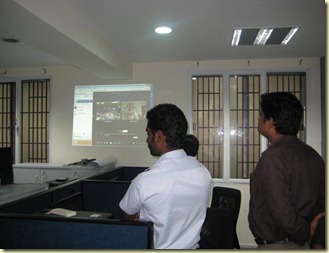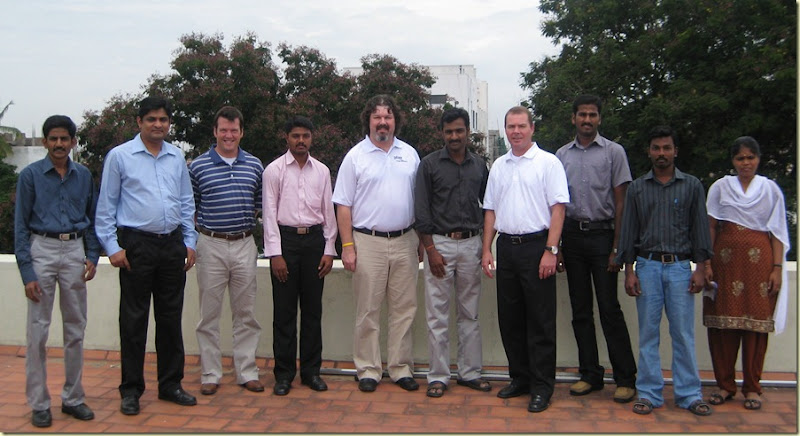It’s difficult to put into words what a eye opening experience it’s been coaching our development team in Coimbatore, India over the last three weeks. As with anyone, my view of people and the world is largely limited by lack of experience. An interaction here or there with an India based development team has really been all that I have had to base my experiences on and with this limited experience I’ve come to realize I’ve developed some unrealistic beliefs about IT in India. I’m extremely thankful for the opportunity to dispel many of the myths that I’ve had about this gigantic and growing population of developers in India. Here are the top ones:
Myth #1: Indian Developers are Subpar
I had assumed that the caliber of development with the team over here would be pretty substandard. I’ve worked with a couple of different offshoring teams and interacted with a number of people who have done the same. The common lessons learned across those interactions have been, don’t give the offshore team any challenging work and relentlessly review the code when it comes back in. Many people I know attribute this to a lack of technical knowledge with the offshore developers. People believe they are only a year or so out of school and that they don’t have anywhere close to the amount of programming time that their counterparts in the US have.
Maybe this holds true for bigger segments of developers, but we were extremely fortunate to have six really talented developers on our team. Additionally, within the sixty developer company where they work they are more the norm than the exception. Each team member was extremely comfortable in C#, .NET, SQL, and a number of other technical skills. When technologies were new to the team, they were able to quickly and effectively pick up working knowledge of the tools with a little help from us. We quickly changed our plan from trying to teach technical skill to teaching craft and improving process within our first couple days here. In my opinion the difference between the developers I work with back home and the ones over here is mainly just experience with test driving development.
Myth #2: Communication Will be Easy
Everyone speaks English right? Well at least a country that was colonized by England speaks English, right? Uh, no. The difference between the Indians who have frequently interacted with Americans and those who haven’t was astounding. Communicating with our taxi driver was largely primitive grunting and pointing. There were two members of our group were fluent in English and had little trouble understanding us when we slowed our pace of speech down to a reasonable level. The other five members of the team had difficulty understanding us unless we were gesturing, speaking very slowly and enunciating very well. Neither Tim nor I were able to master speaking to this group effectively. 
We did find however that everyone on our team was able to read English and all of their code is written in English so we were able to use that as a common denominator. With a little bit of translation help then we were off and running. We’d favor walking through code on a projector as a team and showing by example the practices that we were trying to teach. Ideas and concepts that we felt were extremely important were captured as reference in our wiki on GitHub. It’s a difficult problem to solve when so much of our success relies on frequent, open and honest communication. As we move forward with 8000 miles between us, we’ll leverage IM, shared living documents, and timely feedback with daily standups, weekly retrospectives and demos.
Myth #3: Cultural Differences are not that Wide
I knew that there would be cultural differences but I really had no idea how different the people are here from back home. I had brushed up on the differences with a great book, Speaking of India by Craig Storti, but to understand the impact they have they really must be experienced. The most challenging one to overcome was the rigid hierarchy in the workplace. When the owner of the company was in the room, no team member spoke except for the team lead and he would only reply with a “Yes” or “Yes, sir”. When the team was asked for feedback they would defer to the team lead every time. If he was out of the room, they would defer to the “secondary team lead”.
This rigid hierarchy was stifling communication which as I mentioned before must be open, direct and honest. We didn’t really try to overcome cultural standards that have been ingrained in this group since the beginning of their lives. Instead we picked our opportunities to have direct conversation with individuals and to solicit feedback from the group as much as possible when they were their most honest (bosses out of the room).
Myth #4: Little Effect can be had in Three Weeks
I’ve worked with a number of really good trainers, coaches, and teachers of Agile techniques and everyone routinely agrees that to get somewhat proficient at Test Driving, Refactoring, and Emergent Design takes months. I have no intention of being in India, away from my family for months, so the question of how much change we could enact in three weeks was really concerning. I’m not foolish or egotistical enough to think that the developers we’ve worked with are now proficient at TDD, Refactoring, or anything else that we’ve tried to teach them. Further, I know that they will start to regress once we’ve returned to the states. I do believe, however, that these guys already had an inherent thirst for knowledge. We were able to show them the benefits of every practice we talked about and you could see in their eyes and hear in their conversations that they were excited and eager to continue the voyage. Will they become proficient in the same time as if we were with them? Probably not. Will they continue down the path? Definitely. These guys already had the spark of interest going, the most important thing that we were able to accomplish over here was to just fan the flame.
In all, this trip has taught me to question all of my preconceived notions about people. I am hopefully returning from India, humbled, grateful, and much more respectful of the great country and it’s people. Despite conditions that many Americans would find below standard, the people of India are as welcoming and hospitable as any I have ever met. I am thankful for the opportunity to learn more about their culture and I look forward to continuing to build some great software with this team.
Senthil, Antony, Chenthil, Perumal, Sathish, Govind, and Priya, you were all extremely gracious and patient with the boisterous Americans. You made us feel very much at home when we were in need and we will forever be thankful!
தங்க யு கோயம்புத்தூர்




